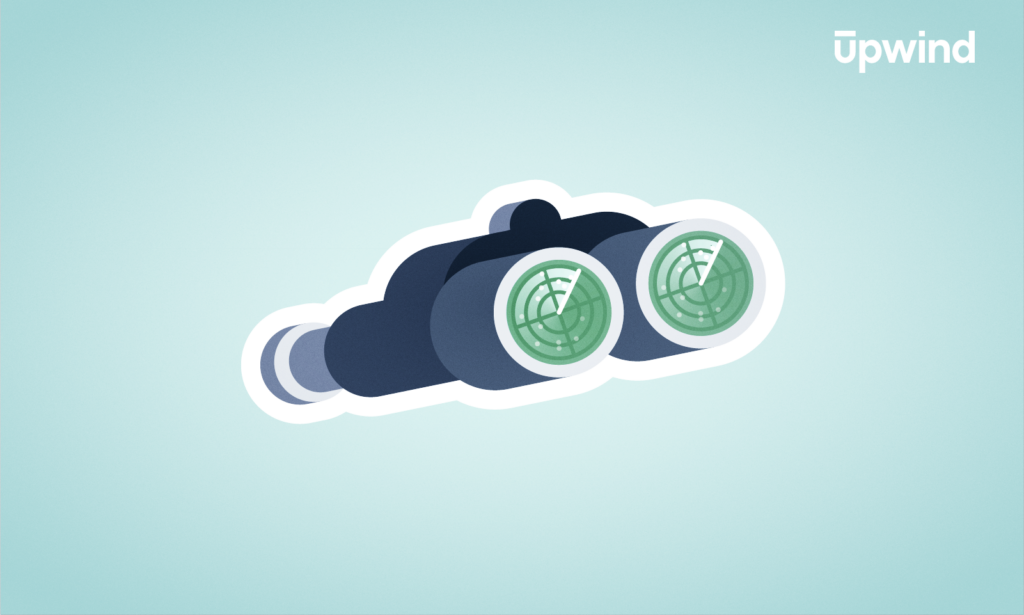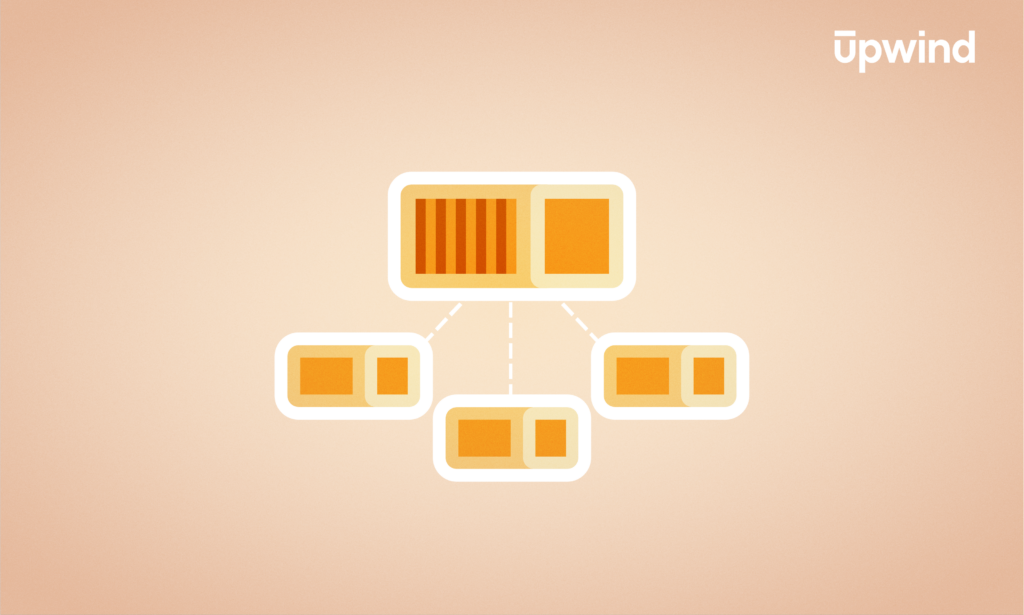
With the wide adoption of containerized applications, there’s an increasing demand for solutions that simplify container management in cloud environments. Amazon Web Services (AWS) Fargate aims to fill this gap by offering a serverless computing platform that streamlines container deployment without requiring developers to manage the underlying infrastructure. While AWS Fargate can make life easier for developers, especially in speeding up development cycles, it’s worth noting what that means for Fargate container security in more detail. In this article, we’re first starting with the basics: exploring what Fargate is, its features and use cases, and differences from other container management services.
Recap: An Overview of AWS Fargate
AWS Fargate is a fully managed, serverless computing engine that facilitates running containers in the cloud by removing the need for direct infrastructure management. Built to integrate seamlessly with Amazon Elastic Container Service (ECS) and Amazon Elastic Kubernetes Service (EKS), Fargate handles the provisioning, configuration, and scaling of containers, allowing developers to focus exclusively on application development rather than infrastructure management.
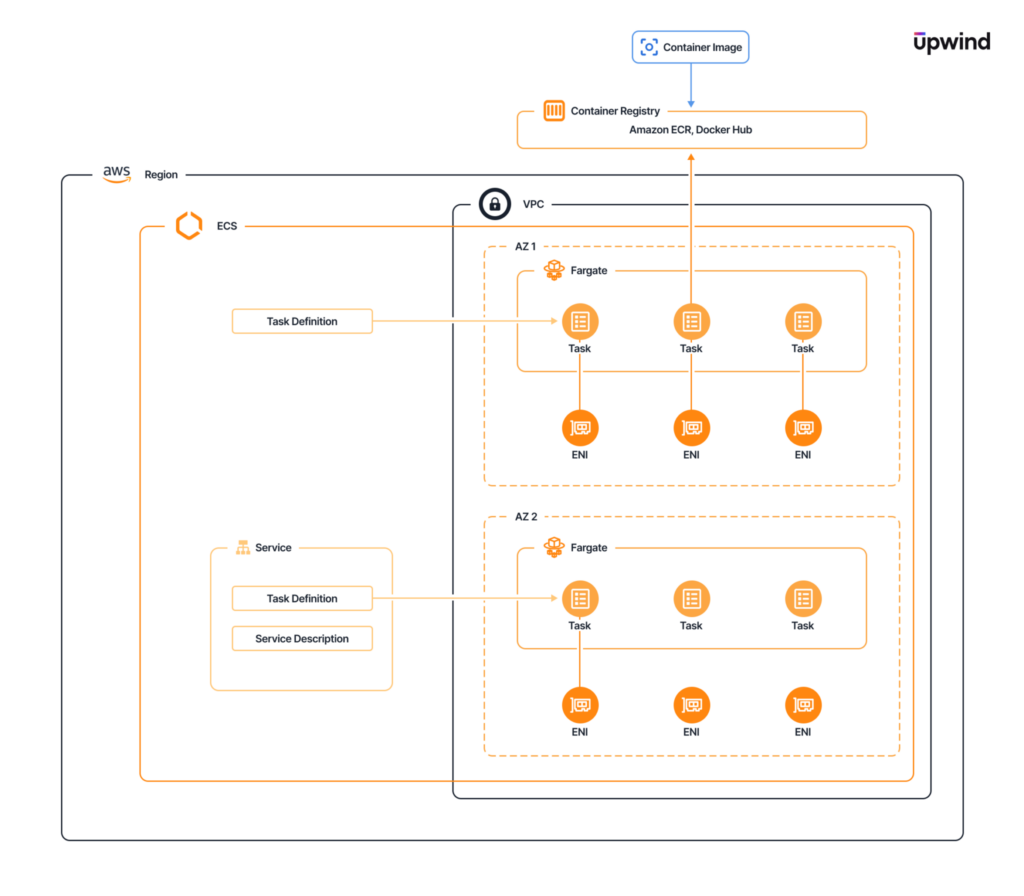
By abstracting away the underlying infrastructure, Fargate significantly reduces operational complexity and minimizes exposure to common server-level vulnerabilities. For security-conscious teams, this abstraction is crucial — it reduces potential attract surfaces by eliminating host access and managing patching and system-level maintenance.
AWS Fargate orchestrates clusters of virtualized compute environments to execute container tasks, managing setup steps like:
- Provisioning: Automatically allocating resources for containers on demand.
- Configuring: Establishing essential configurations, reducing the risk of configuration drift.
- Scaling: Adjusting resources to meet demand dynamically, ensuring both optimal performance and efficient resource use.
With Fargate, development teams specify only the required technical resources for the container, such as CPU, memory, and network needs. Fargate handles the rest. This frees up valuable time and resources for development teams, allowing them to focus on deploying and managing their containerized applications efficiently and reliably while leaving infrastructure management to Fargate.
Runtime and Container Scanning with Upwind
Upwind offers runtime-powered container scanning features so you get real-time threat detection, contextualized analysis, remediation, and root cause analysis that’s 10X faster than traditional methods.
The Promises and Challenges of AWS Fargate
Since its release, AWS Fargate has seen widespread adoption, enabling organizations to run containerized workloads with serverless convenience. Its promise to eliminate infrastructure management and streamline container deployment has fueled its popularity among businesses seeking rapid deployment without scaling challenges or intensive overhead.
Organizations adopt containers for efficiency, but 37% report that over half their container workloads require rightsizing to optimize costs, CPU, and memory use as they scale.
While Fargate offers compelling tech efficiencies, organizations that have embraced it may discover nuanced benefits — and new challenges, like resource management — from real-world use. Here’s an in-depth look at Fargate’s tech outcomes, balancing core advantages with ongoing considerations.
Cost Efficiency
Fargate is a cost-effective solution because it charges for only the resources used by containers. It uses a pay-as-you-go subscription model, which remains a primary attraction, as organizations only pay for the CPU, memory, and network resources their containers use. This model is valuable for scaling workloads in response to fluctuating demand.
However, while cost efficiency is a foundational promise, organizations must monitor resource utilization closely to avoid unexpected expenses in the form of cost spikes, particularly for applications with high or unpredictable scaling needs.
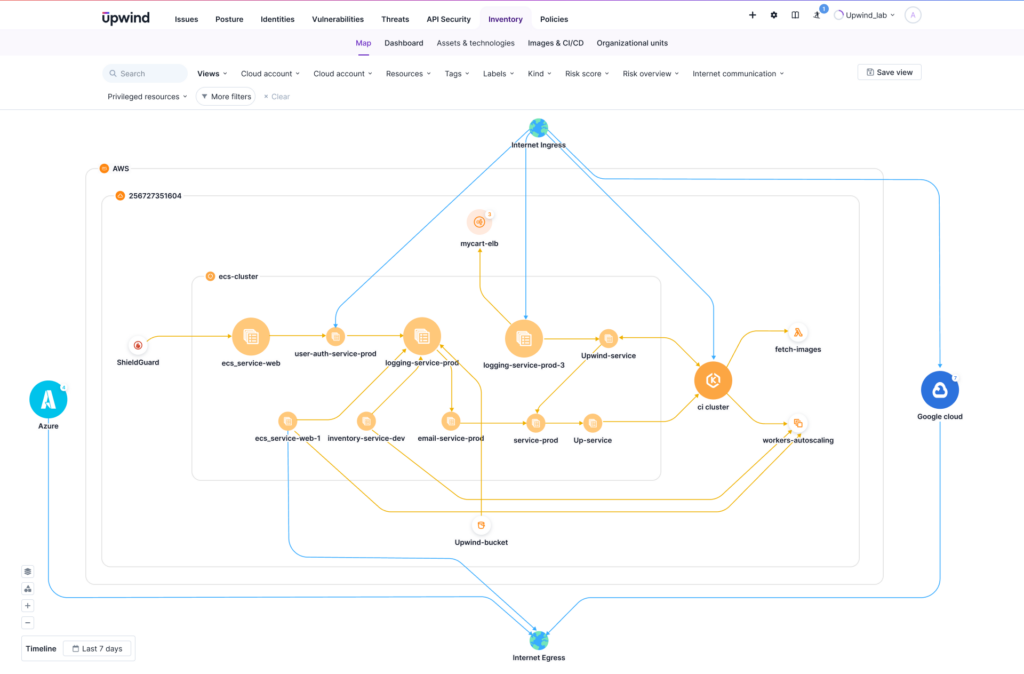
Operational Efficiency
Fargate alleviates a broad array of infrastructure management tasks, like server provisioning, patch management, and scaling, enabling development teams to focus entirely on application code rather than hardware or OS management. This simplified model also reduces the need for specialized DevOps staff to handle container orchestration, which is a significant advantage for small or growing teams.
In practice, the shift creates new dependencies. For instance, as Fargate abstracts away OS management, organizations lose some control over security configurations and infrastructure visibility. These constraints may affect teams who need more customization or advanced security configurations.
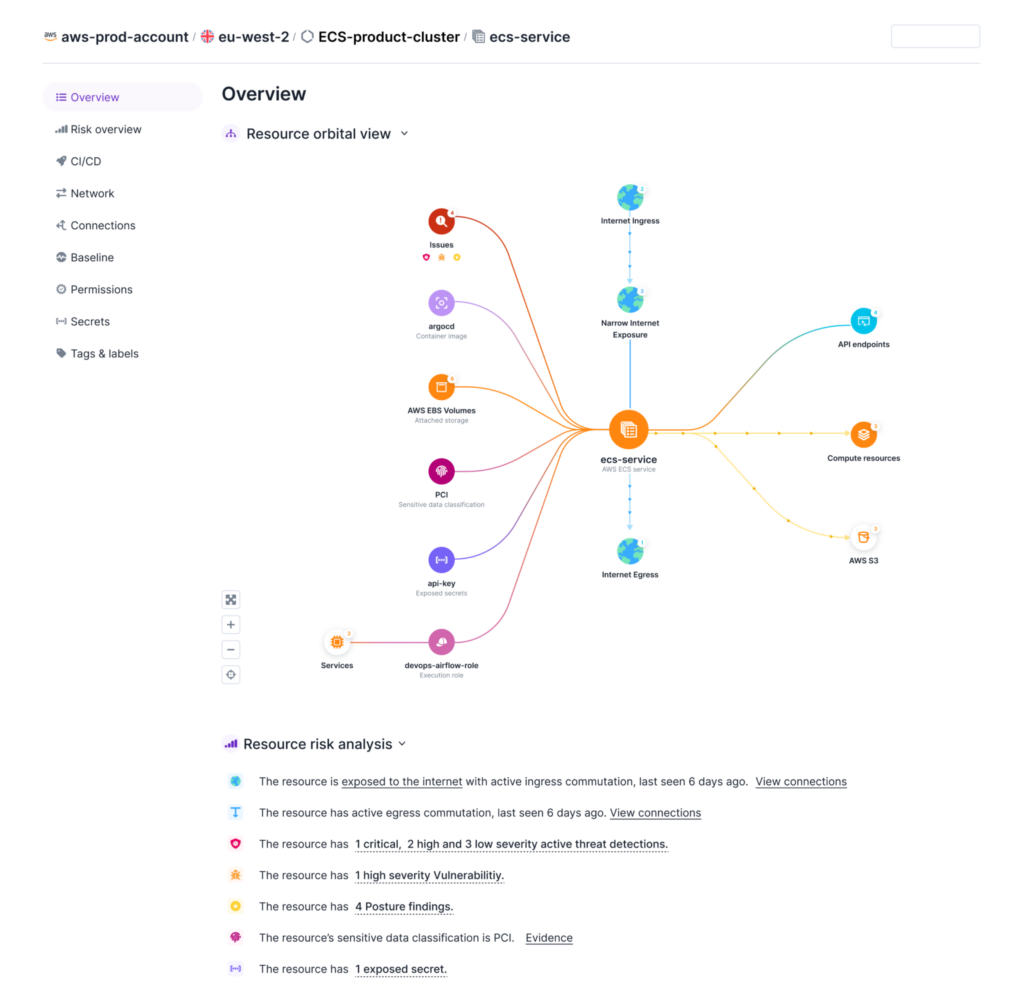
Enhanced Security
Fargate inherently boosts security by isolating each workload in a separate compute environment, reducing the risk of cross-container vulnerabilities and limiting access to the underlying infrastructure. It also supports integration with AWS security services, including IAM for access control, CloudWatch for monitoring, and WAF for application-level protection. This security-focused architecture reduces risk and simplifies compliance with standards like PCI DSS by encrypting temporary storage and securing communications between containers.
The isolated nature of Fargate brings its own challenges. Visibility can be limited at the network and host level as Fargate restricts certain low-level security monitoring and custom intrusion detection capabilities. Industries that require deep packet inspection or granular network monitoring can see gaps, even in an environment where all their container needs are in AWS. Multi-cloud companies see even larger visibility gaps.
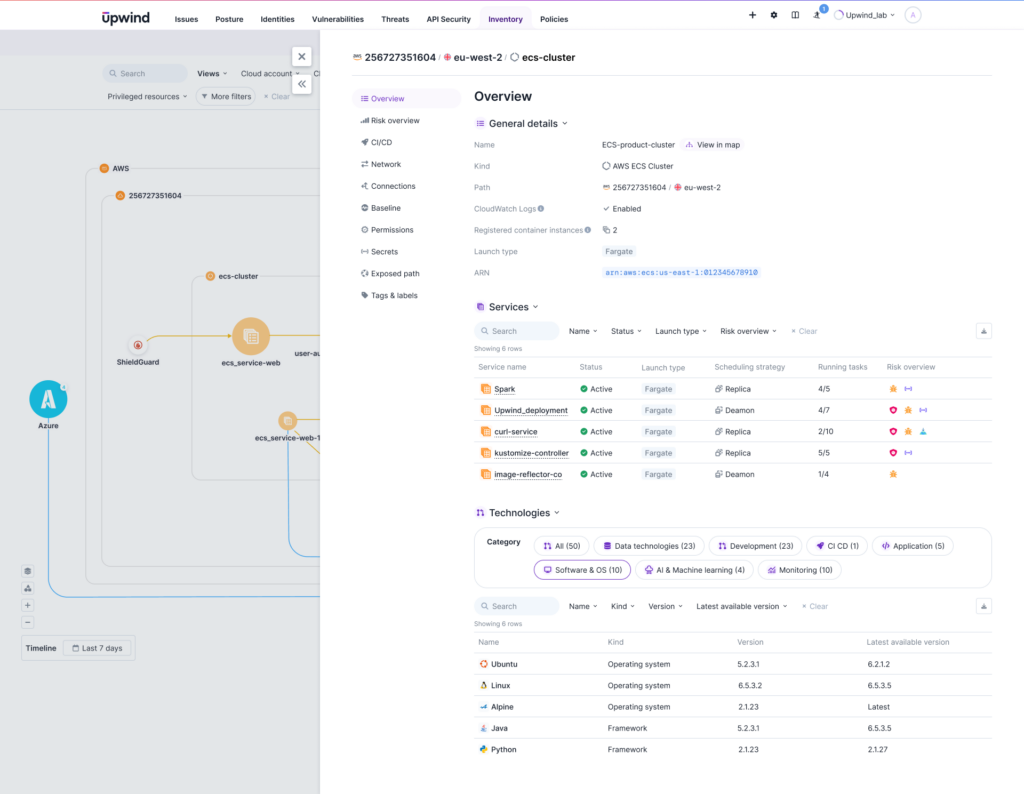
Flexibility and Portability
AWS Fargate offers remarkable flexibility in deploying and managing cloud applications, making it a preferred choice for containerized workloads for the following reasons:
- Fargate supports both ECS and EKS orchestration platforms, allowing developers to migrate between container deployment options.
- Fargate supports various container image formats, such as Docker, which ensures compatibility with various applications, regardless of the existing container setup.
- Fargate gives flexibility when mixing EC2 launch types. For example, developers can run some tasks on Fargate and others on EC2 instances. This capability allows developers to select a different infrastructure for different workloads based on cost, performance, or resource needs.
- Fargate integrates easily with other AWS services, such as CloudWatch for logging and IAM for security. This facilitates the building of secure, scalable applications in the AWS ecosystem.
Yet balancing Fargate and EC2 deployments means rendering security policies consistent across environments. Maintaining portability while ensuring consistent enforcement requires additional configuration and monitoring, particularly when using third-party integrations or migrating workloads between ECS and EKS.
The Components of AWS Fargate
AWS Fargate’s architecture is designed to streamline container management, reducing risks associated with manual infrastructure handling. This table breaks down the essential components and their roles in ensuring resilient application availability. Each feature contributes to reducing attack surfaces, enforcing reliable resource allocation, and maintaining strong controls over task execution and lifecycle management.
| Component | Description | Purpose |
| Clusters | Logical groupings of tasks; developers do not manage servers directly | Provides isolation and organization for workloads |
| Tasks | Represents containers in isolated environments with specific resources like CPI and memory | Ensures dedicated resource allocation and security isolation |
| Task Definitions | Blueprints for task configuration, including images and resource settings | Standardizes deployment configurations to avoid inconsistencies |
| Services | Manages task instances, restarting tasks if they fail | Maintains application availability by ensuring task continuity |
| Lifecycle | Starts with provisioning, executes, then clears resources upon completion | Optimizes resource use and supports scalability |
Use Cases for AWS Fargate
Each component of the Fargate architecture supports specific use cases that make this container management system appealing. Here’s an overview.
| Component | Use Case | Explanation |
| Clusters | Multi-tenant microservices architectures | Provides logical isolation between workloads, ensuring data separation and security compliance without physical server management |
| Tasks | Stateless web applications and APIs | Dedicated CPU, memory, and network resources for each task allow scalable, consistent environments that adjust for traffic demand |
| Task Definitions | Batch processing and data pipelines | Blueprint settings for resource allocation, storage, and networking ensure scalable, repeatable task execution tailed to data-heavy workflows |
| Services | Long-running applications | Service scheduler manages task instances, automatically restarting tasks if they fail, ensuring high availability and continuity |
| Lifecycle Management | CI/CD workflows | Automates resource cleanup after task completion, optimizing costs and enabling rapid iteration for testing and deployment |
AWS Fargate vs. Other Container Services
As organizations expand their containerized applications, selecting the right service depends on balancing control, automation, and operational needs. AWS Fargate is a fully managed, serverless solution, but it’s not the only option within AWS or across cloud environments. Here are the strengths and limitations of other container services in relation to Fargate. Understanding these distinctions can help teams align their choice with their technical requirements, resource capacity, and desired level of infrastructure oversight.
Fargate vs. Amazon EC2
Fargate manages infrastructure tasks automatically, removing the need for direct server maintenance. This contrasts with Amazon EC2, where users have full control over the servers, including instance setup, patching, and scaling, but at the cost of increased management overhead.
Fargate is a good choice for teams looking to reduce operational costs by avoiding server management, while EC2 is better suited to applications requiring complete control over the underlying infrastructure and resources.
Fargate vs. Kubernetes
AWS Fargate and Kubernetes both support container orchestration but cater to different needs based on application complexity and operational focus. Fargate is ideal for development teams focusing on application deployment without managing infrastructure. This makes it particularly useful for small teams launching web applications that need to scale automatically.
Kubernetes, on the other hand, offers greater customization and control, including over some security features, making it the preferred choice for enterprises developing complex, microservices-based applications that need fine-grained control over container deployment, scaling, and network configurations.
Fargate vs. AWS Lambda
Fargate is designed for running containerized applications, including long-running microservices and custom environments, with developers able to specify exact CPU and memory needs. It is suited to continuous workloads, like processing data streams from IoT devices, that require stable, ongoing resource allocation.
In contrast, AWS Lambda is an event-driven, serverless compute service optimized for short-lived tasks. It automatically scales in response to triggers (e.g., API calls, file uploads) and is more efficient for single-purpose, brief functions. Lambda is less suited for tasks requiring continuous execution or custom runtime environments.
Fargate: ECS vs. EKS Implementation
Choosing between ECS (Elastic Container Service) and EKS (Elastic Kubernetes Service) with Fargate depends on the orchestration needs of the project:
- EKS is best suited for complex, microservices-based applications
- ECS is easier for newcomers to container development, with a simpler learning curve and fewer resource demands
Upwind Enhances Fargate Deployment Security
Fargate comes with powerful advantages in reducing operational overhead and simplifying container deployment. But it also introduces unique security and management challenges. Upwind’s CNAPP provides tools to bridge the gap, adding visibility, enhancing threat detection, and monitoring resources across Fargate environments at runtime. Its approach is ideal for Fargate, where direct access to underlying infrastructure is abstracted.
To see how Upwind tailors security to the needs of modern container infrastructure, schedule a demo with our team.
FAQ
What is Fargate vs. ECS?
AWS Fargate and Amazon ECS are both designed to run containerized applications on AWS, but they handle infrastructure management differently, offering distinct levels of control and operational flexibility. Fargate is a serverless compute engine, while ECS provides more control by allowing users to configure and manage their own instances.
What is Fargate ephemeral storage?
AWS Fargate ephemeral storage is temporary storage allotted to containers while they run. This storage is isolated per task and can be used for data that only needs to persist for the task’s duration. AWS Fargate platform 1.4 tasks receive up to 20 GB of ephemeral storage for tasks such as data processing or temporary caching.
Is Fargate Paas or Saas?
Fargate is best categorized as a platform as a service (PaaS). It is a managed environment where developers can run and manage container applications without handling underlying infrastructure. Unlike software as a service (SaaS), which delivers fully built software applications for users, Fargate offers the platform and tools to build, deploy, and scale applications on AWS.
Is Fargate similar to Docker?
Fargate and Docker are related but serve different roles in the container ecosystem. Fargate is a managed service that allows users to run Docker containers in the cloud without managing the underlying infrastructure. Docker is a tool for creating, packaging, and managing containers.
Is Fargate better than Kubernetes?
Whether Fargate or Kubernetes is “better” depends on the needs of the specific use case and the level of desired control. Fargate provides a fully managed service. Users do not have to handle node provisioning, patching, or scaling, making it ideal for teams prioritizing simplicity and reduced infrastructure management. Kubernetes requires managing cluster nodes, even in managed services like Amazon EKS. It provides control over configurations, networking, and scaling. Kubernetes is practical for complex, highly customized applications.
Is Fargate the same as Lambda?
AWS Fargate and AWS Lambda are similar in that they both provide serverless compute services, but they’re designed for different types of workloads, and they operate in different ways. Fargate runs containerized applications. Lambda runs code in response to events (e.g., HTTP requests, database changes) and is optimized for short-lived, event-driven tasks.
Lambda simplifies deployment, abstracting nearly all infrastructure concerns, running code only when triggered, and is best for lightweight event-driven functions.



